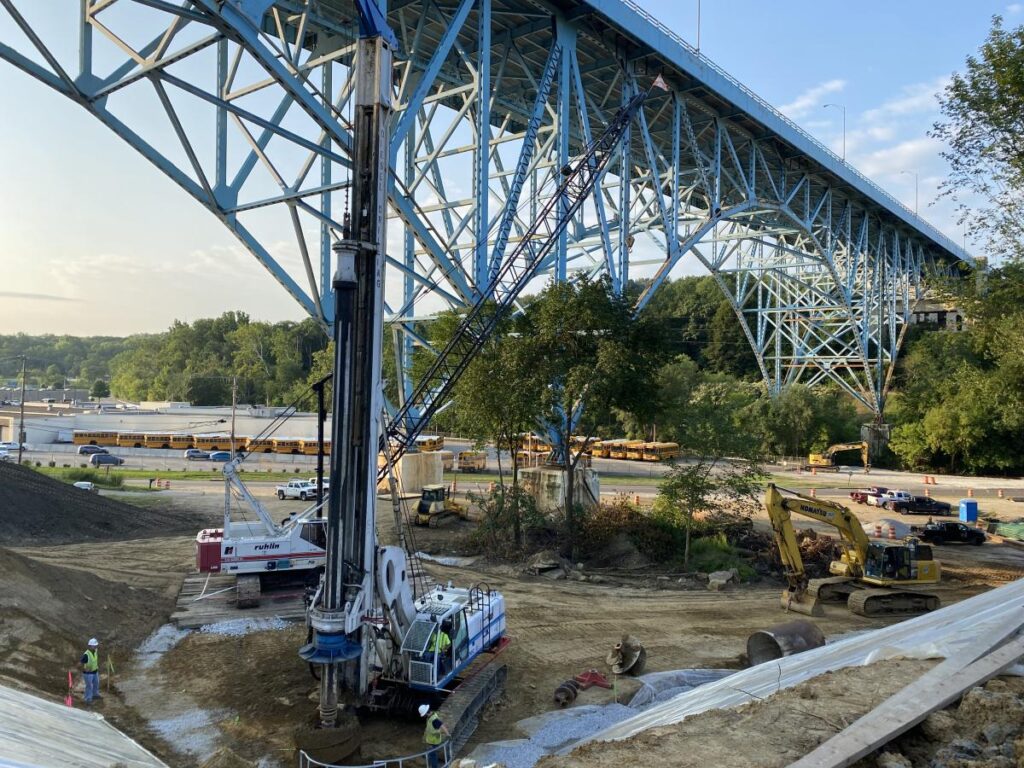Photo courtesy of the Ohio Department of Transportation
After a three-year delay, construction crews have begun clearing land and moving dirt on the $158 million Akron, Ohio, SR 8 bridge replacement project.
After a three-year delay, construction crews have begun clearing land and moving dirt on the $158 million Akron, Ohio, SR 8 bridge replacement project.
“Project design was essentially complete when statewide funding priorities changed due to the pandemic-related economic shortfalls,” said Ramon Marsch, spokesman of the Ohio Department of Transportation (ODOT). “This project was initially scheduled to go out to bid in 2020 but was pushed back. The bridge was fine. There were no safety issues, so we were able to push it back safely.”

Photo courtesy of Ramon Marsch
The contract was awarded to Ruhle/Great Lakes SR 8 Joint Venture Project in the spring of 2023 with work getting under way in August.
The project involves replacing the existing 1,500‐ft. long, 180-ft. high, blue‐painted steel bridge carrying SR 8 over various railroads, North Street and the Little Cuyahoga River. Two new side-by-side bridges will replace the one existing bridge. The new bridge will feature an additional lane in each direction for a total of four lanes in each direction.
“That will help dramatically with traffic,” Marsch said.
One of the major challenges in designing the project was minimizing impacts to the 115,000 travelers who use the bridge daily. “It is a vital component of the transportation infrastructure in northeast Ohio and provides a critical link for commuters and commerce to the government, medical, university and other commercial facilities in downtown Akron and beyond,” Marsch said.
To keep traffic flowing, “SR 8 traffic will continue to travel on the existing bridge while the first new bridge is built to the west,” Marsch said. “All six lanes of SR 8 traffic will then be shifted onto the new bridge. The existing SR 8 bridge will be removed, and the second new bridge will be constructed in the same location. It is expected that SR 8 traffic will be maintained throughout the duration of the project. However, short term ramp closures may be needed at the Perkins Street and Glenwood Avenue interchanges.”
The project also will extend the northbound entrance ramp from Perkins Street across the bridge to become the exit ramp for the Glenwood Avenue interchange. For SR 8 south, the southbound entrance ramp from Glenwood Avenue will extend across the bridge to the exit ramp for the Perkins Street interchange.
Noise walls will be constructed along SR 8 at four locations — on the west side of SR 8 between Glenwood Avenue and Lookout Park; the east side of SR 8 between the former Naval and Marine Corps Reserve Center and Celebration Church; on the west side of SR 8 between Adams Street and Perkins Street; and on the east side of SR 8 between Adams Street and Perkins Street.
Crews are working with yard cranes and hydraulic hammers for pile driving the bridge foundations and bulldozers and excavators for grading and excavation work. The bridge was originally constructed in 1953 to provide a grade separation for what was formerly called the Akron Expressway — now SR 8 — as it crossed over the Little Cuyahoga River, five railroad corridors, the Pennsylvania and Ohio Canal and East North Street.
Photo courtesy of Ramon Marsch
To extend the life of the bridge, numerous maintenance activities have been performed over the years. However, it has continued to deteriorate, and maintenance activities will be performed as needed while it remains in use.
ODOT also has worked with Summit Metro Parks and the city of Akron both to minimize impacts on users of the Freedom Trail located below the bridge and to enhance the trail with permanent improvements. Those improvements include a new paved connector trail spur to link Perkins Street and Freedom Trail, as well as an “exciting scenic overlook feature to be constructed under the new bridges behind Freedom Trail.” ODOT has planned two separate six-month closures of the trail and other short-term closures or restrictions. A trail detour will be provided.
“Aesthetics also is an important component of the project features, such as the delta-style bridge piers, lighting, fencing, a unique approach feature, the Freedom Trail overlook and the highway side of the noise walls,” Marsch said. “The project team has had many conversations with numerous local stakeholders regarding the aesthetic features because they recognize the bridges will be a prominent community feature for decades to come.”
The project is scheduled for completion in 2028. CEG
Read the full article here

